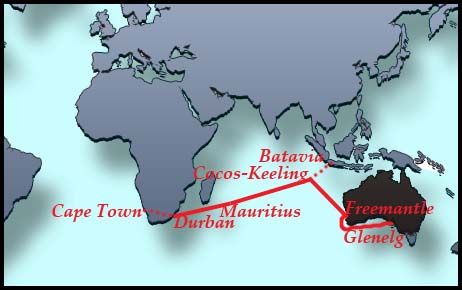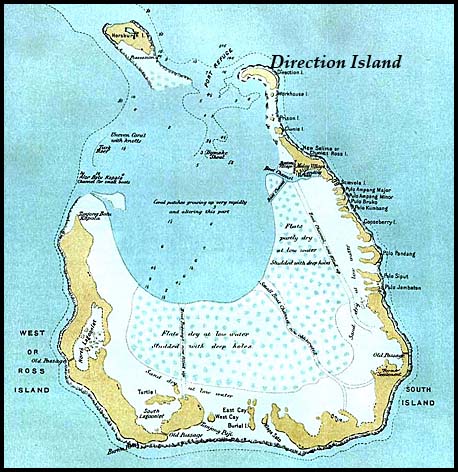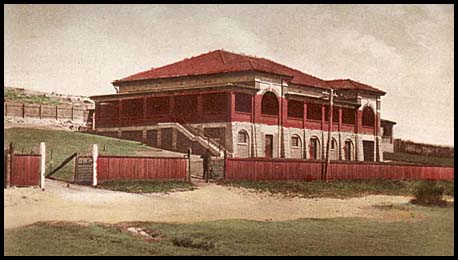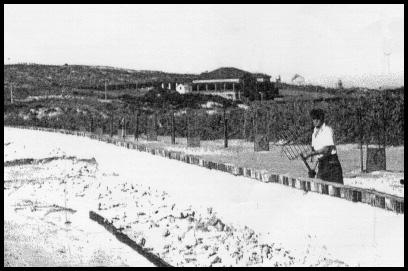Laying the Cape to Cottesloe (Fremantle) cable.
- Australia 1901-1988
- New South Wales
- Overview of NSW
- Telegraph lines
- Telegraph Offices
- Date stamps
- Forms
- Envelopes
- Instructional annotation
- Collect
- Delayed
- Free
- Immediate Urgent
- Reply paid
- Rates
- Stamps
- 1871 Telegraph stamps
- 1885 proposal
- 1893 proposal
- Queensland
- South Australia
- Tasmania
- Victoria
- Western Australia
- International
- Special aspects
On 9 July 1900, a contract was let to the Telegraph Construction Company for the manufacture and laying of the Cape cable - from Durban via Mauritius, Rodriques Island, Cocos Islands and Fremantle (Glenelg). It was envisaged the work would be completed within two years. That work would provide cable communication between Land's End in England and Glenelg via Cape Town. The estimated cost to the Eastern Extension Telegraph Company was £2,750,000. Mr. Warren, the Australasian Manager of the Eastern Extension Company, recommended the NSW, Victoria and Tasmania Government's accept the Company's offer as the Imperial Government had granted all necessary landing rights for the Cape-Australian cable to connect through Mauritius, Rodrigues and Cocos to Fremantle and South Australia.
The task of laying the submarine cable from South Africa to Australia commenced in 1901. The route is shown in the map and described briefly below.
The link between Cape Town and Durban was a land line of 750 miles.
The stations on the route from Cape Town were:
- Durban, South Africa;
- Mauritius;
- Rodrigues;
- Cocos-Keeling Islands;
- Cottesloe/Fremantle;
- Adelaide/Glenelg.
Another cable was also laid in this area - from Cocos Islands to Batavia in 1908 by C. S. Patrol. |
 |
Completed: 1901; Length: 1,375 nm; Cable ship: C.S. Anglia. Laid by: |
Completed: 1901; Length: 417 nm; Cable ship: C.S. Anglia. Rodrigues was a dependency of Mauritius. It is about 330 miles ENE of Mauritius and has an area of about 43 square miles. |
13 September 1901 - news from Mr. J. C. D .Jones, the electrician in chief of the Eastern Extension Telegraph Company that the steamer Anglia was then engaged in paying out the cable from Mauritius towards Rodriguez.
Completed: 1901; Length: 2,157 nm; Cable ship: C.S. Anglia. Cocos is described as being "about 800 miles from anything else". The Eastern Extension Telegraph Company leased land on Direction Island from the Clunies-Ross family. A cable station was constructed on the island in 1901 and it operated until it was closed in 1966. A wireless station to communicate with ships was established in 1910. On 9 November 1914, a wireless operator on Cocos sent a message about the German raider SMS Emden and the HMAS Sydney sailed to investigate. The Emden crew came ashore and cut the cable link to Perth but not that to South Africa. |
 Cocos Keeling Island - one of two islands and 27 coral atolls - showing Direction Island. |
A time-line of the Cocos Keeling Islands can be accessed elsewhere.
From 1909, a barrel mail system was introduced on Cocos Keeling Islands which still operated in 1951. The Post Office was opened in 1933.
The people of Cocos voted to become part of Australia in 1984.
| Completed: November 1901;
Length: 1,721 nm; Cable ship: C.S. Scotia. In July 1900, a site was chosen for the Western Australian landing station at Cottlesloe Beach - about three miles north of Fremantle. Provision was made for a building similar to the one to be erected near Adelaide at the Grange near Glenelg. |
 The Cottlesloe Cable Station. |
| Cable & Wireless recovered part of the cable between Cottesloe and Cocos during 1948. |
 The cable station from the beach. |
CAPE TO GLENELG CABLE.
AUSTRALIAN CONGRATULATIONS. MELBOURNE.
Register (Adelaide) 28 October 1901 (p. 5) - (published in advance of the event).
"In response to an invitation from Mr. W. Warren, manager in Australasia for the Eastern Extension Telegraph Company, the Prime Minister dispatched this following cable message on Saturday in connection with the opening to traffic of the Australian section of the Cape cable on Thursday, 1 November 1901, to the Premier of Cape Colony:
"Australia congratulates Cape Colony upon the completion of direct cable communication between the two countries, and trusts that South Africa may soon be a powerful federation within the empire. Hearty goodwill".
A similar message was dispatched to Natal and to the Colonial Secretary at Mauritius:
Mr. Barton cabled: Australia congratulates Mauritius on the completion of direct cable communication between the two countries, and hopes that her hearty goodwill is reciprocated".
The Sydney Morning Herald of 4 November reported that:
"Congratulatory messages were exchanged on Thursday 1901 (1 November) over the Cape-Australia cable between the Eastern Extension Company, London, and the Western Australian Government, and between the Governors of Western Australia, Mauritius, and Natal".
Messages were also sent by the Premier of New South Wales to the Colonial Secretary, Mauritius and to the Premiers of Natal and Cape Colony.
Although various messages, etc were sent at different time, the official day for opening the cable is taken to be 1 November 1901.